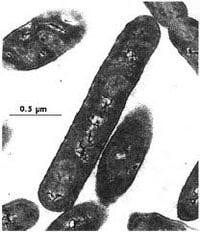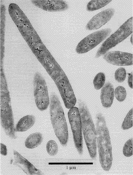Bacillus infernus
A Microbial Biorealm page on the genus Bacillus infernus
Classification
Higher order taxa
Bacteria; Firmicutes; Bacilli; Bacillales; Bacillaceae; Bacillus
Species

Bacillus infernus
Nonmotile rods (including possible yet unconfirmed endospores) inhabiting the deep terrestrial subsurface of the Taylorsville, Virginia Triassic Basin. The organism is thermophilic, halotolerant, and slightly alkaliphilic. B. infernus is important because it can affect geochemical processes including transport of toxic chemicals similar to other subsurface microorganisms. B. infernus also possesses a “novel” metabolism perhaps useful in future bioremediation of the environment, biotechnology, and industry.
Entire genome not sequenced yet. The chromosomes of B. infernus are linear. 16S rDNA partial sequencing of two anaerobic strains (Th-22 and TH-23) have been studied via PCR amplification. The isolated portion contains nearly the entire gene; approximately 1500 base segments. The study concluded B.infernus should be classified as a new Bacillus species based on RDP database information
Cell and colony structure
Interesting features of cell structure. Interesting features of colony structure.
Metabolism
Energy source(s); external electron donor(s) (=reductant source(s)); carbon source(s); oxygen classification; important molecules it produces.
Ecology
Habitat; symbiosis; contributions to the environment. metagenomic data link
Pathology
How does this organism cause disease? Human, animal, plant hosts? Virulence factors.
References
List your references here with hyperlinks to the papers or websites when possible. Also, provide the DOI number for articles. For example:
Edited by Matt Flynn, a student of Dr. Lisa R. Moore, University of Southern Maine, Department of Biological Sciences, http://www.usm.maine.edu/bio


